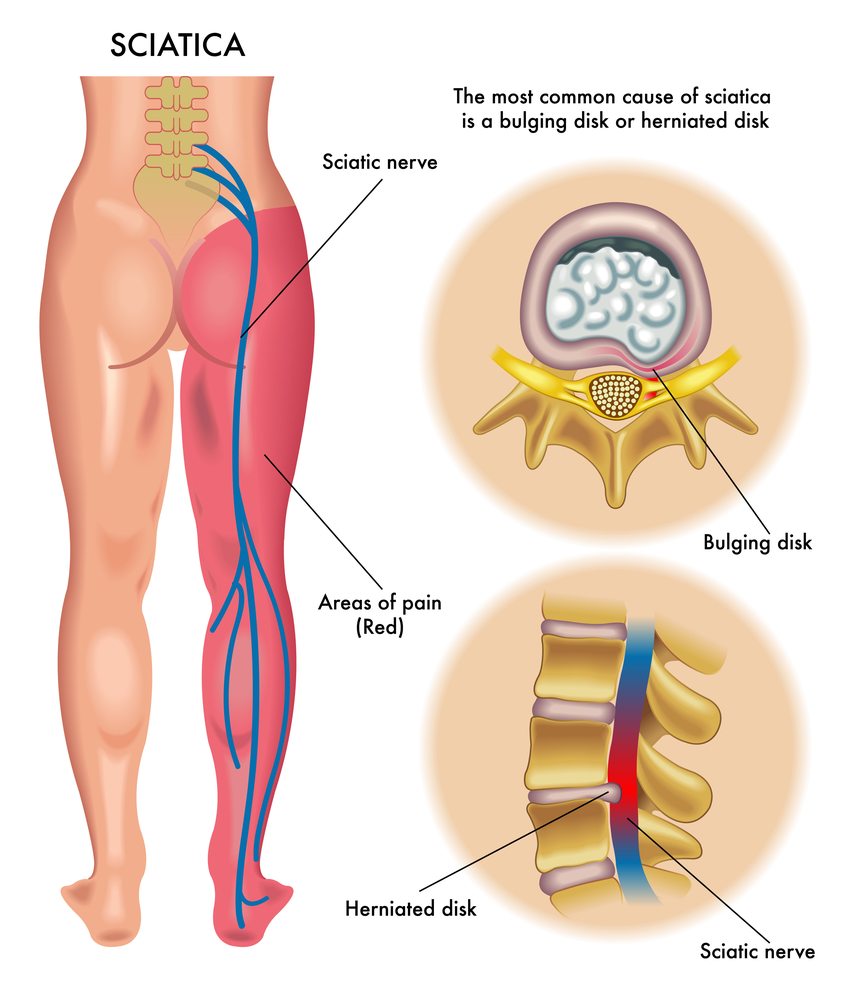Sciatica
Will Foot Numbness with Sciatica Go Away?

Sciatica, a term often resonating in the corridors of healthcare, refers to pain radiating along the sciatic nerve. This nerve runs from the lower back, through the hips, and down each leg.
Read more about Will Foot Numbness with Sciatica Go Away

One common symptom of sciatica is foot numbness. Understanding the underlying condition causing sciatica is essential for proper diagnosis and treatment.
More about Will Foot Numbness with Sciatica Go Away
The Link Between Foot Numbness and Sciatica
Foot numbness can be particularly distressing. The numbness in your foot may be due to compression of the sciatic nerve, and this symptom is prevalent in individuals with herniated disks.
Understanding Foot Numbness
Foot numbness with sciatica is typically caused by the compression of the sciatic nerve or its roots. It may feel as though your foot has fallen asleep, and sometimes you might experience a dull ache or sharp pain.
Can Foot Numbness Be Treated?
The treatment of foot numbness focuses on alleviating the compression of the sciatic nerve and addressing the underlying cause of sciatica. Physical therapy and gentle exercise are highly beneficial in relieving symptoms. However, in cases of cauda equina syndrome, which involves the compression of the nerve roots at the base of the spine and may lead to loss of bowel or bladder control, it is considered a medical emergency, and immediate surgery is required.
The Impact of Sciatica and Foot Numbness on Quality of Life
Living with sciatica and foot numbness can affect day-to-day life considerably, especially if the condition becomes chronic. Discomfort and mobility issues can impact various activities, including work, leisure, and basic daily tasks.
It’s important to request an appointment with a primary care provider or a specialist in medical specialties related to back pain and nerve damage, such as neurology or orthopedics.
Preventing Sciatica and Associated Foot Numbness
Preventive measures can play a pivotal role in avoiding sciatica and the resulting foot numbness. Regular physical activity, maintaining a healthy weight, proper lifting techniques, and ergonomic workstations are a few strategies that can help prevent sciatica.
Unraveling Sciatica
What is Sciatica?
Sciatica typically involves pain that radiates along the path of the sciatic nerve. It is often caused by the compression of nerve roots in the lower spinal column. The pain can vary from a mild discomfort to a sharp burning sensation and may also cause numbness and tingling in the affected leg.
The Sciatic Nerve:
The sciatic nerve is the longest nerve in the body and consists of several nerve roots that exit the spine in the lower back. The nerve then runs through the hip and buttock area and continues down the back of each leg.
Common Symptoms:
Pain in the leg or buttock, often worsened by sitting
Burning sensation or tingling in the leg
Weakness or numbness in the foot or leg
Difficulty moving the leg or foot
Constant pain on one side of the buttock
People with sciatica may also experience ankle pain and foot numbness. The sensation might be akin to ‘pins and needles,’ especially in the toes.
Understanding the Anatomy of Sciatic Nerves
The sciatic nerves are the longest in the body, originating from several nerve roots that exit the spine in the lower back. The sciatic nerve runs through the hip and buttock area, down the back of each leg to the lower leg and foot, dictating sensation and movement in these areas. These nerves are integral to the experience of leg pain and foot numbness that’s often associated with sciatica.
What Causes Sciatica?
Sciatica can result from various underlying conditions:
Herniated Disc:
One common cause is a herniated disc in the lumbar spine. A disc herniation occurs when the inner content of a spinal disc protrudes, potentially compressing the sciatic nerve. This is often referred to as a “slipped disc.”
Lumbar Spinal Stenosis:
This is the narrowing of the spinal canal in the lower back, which can compress the nerves, including the sciatic nerve. Lumbar spinal stenosis is often a result of degenerative disc disease or bone spurs.
Piriformis Syndrome:
In this case, the piriformis muscle (located in the buttock area) irritates or compresses the sciatic nerve, leading to sciatica.
Other Causes:
Other causes include spondylolisthesis, tumors, infections, and injuries to the lumbar spine.
Some factors can increase your risk for sciatica, such as age, obesity, occupation, prolonged sitting, and diabetes.
Diagnosing Sciatica
Physical Examination:
A healthcare professional will conduct a physical examination to diagnose sciatica. This might involve observing your posture, range of motion, and physical condition and inquiring about the location and severity of the pain.
Medical Imaging:
In certain cases, MRI or X-ray may be used to provide a detailed view of the spine.
Treatment Options:
Conservative Treatments:
In many cases, sciatica can be treated conservatively. This includes pain medication, such as Ibuprofen, physical therapy, and using an ice pack or heating pad on the affected areas.
Physical Therapy:
Physical therapists can design specific exercises for sciatica, which often focus on improving posture, strengthening the muscles supporting the back (including abdominal muscles), and increasing flexibility.
Medications:
Pain medications and muscle relaxers are commonly prescribed to alleviate pain and muscle spasms associated with sciatica. In certain cases, steroid injections may be used to reduce inflammation around the nerve roots.
Alternative Therapies:
Some individuals find relief through alternative therapies such as acupuncture, chiropractic adjustments, or massage therapy.
Comprehensive Treatment Plans for Sciatica and Foot Numbness
Effective treatment for sciatica usually involves a combination of medication, physical therapy, and lifestyle modifications. Anti-inflammatory medications and other treatments, such as muscle relaxants, help to reduce pain and muscle spasms caused by sciatica. Regular aerobic exercise can also be a home remedy to relieve sciatica and prevent the condition from getting worse or becoming chronic sciatica.
The Role of Physical Therapy in Sciatica Management
Physical therapy plays a significant role in managing sciatica pain and foot numbness. Specific exercises designed for sciatica patients often aim at improving posture, strengthening back-supporting muscles, and enhancing flexibility.
For example, exercises that involve keeping one leg straight and bending the other leg with knees bent can help stretch the affected nerve, relieving symptoms of sciatica.
Role of Medication in Managing Sciatica and Foot Numbness
Several classes of medications can help manage sciatica symptoms. Anti-inflammatory drugs are typically used to reduce inflammation around the nerve roots, while pain medications can alleviate leg pain and foot numbness caused by sciatica. Muscle relaxants and nerve pain medications are also employed to help control chronic pain.
Alternative Treatments for Sciatica
Non-traditional methods of treating sciatica, like acupuncture or chiropractic care, can be effective for some people. Such alternative therapies may provide relief from the pain and discomfort caused by sciatica, further supporting conventional treatment and prevention strategies.
Surgical Interventions for Severe Sciatica
In severe cases where conservative treatments are not effective, surgery may be necessary, especially if there is significant muscle weakness or loss of bowel or bladder control.
Sciatica surgery options may involve microdiscectomy or laminectomy to relieve pressure on the pinched nerves. These procedures have high success rates in treating foot numbness and leg pain caused by severe sciatica.
Unveiling the Truth: Will Foot Numbness with Sciatica Go Away?
Understanding the interplay between foot numbness and sciatica is essential for effective treatment and management.
Whether the numbness is a fleeting visitor or a long-term guest, addressing the root cause is key. A tailored treatment plan that may include medication, physical therapy, and in some cases, surgery can pave the way for recovery.
It’s important to remember that managing sciatica is a journey that requires both physical adjustments and mental wellbeing. Stay informed, stay proactive, and never hesitate to reach out to healthcare professionals for support.
FAQs
How long does sciatica usually last?
Sciatica usually lasts for a few weeks, but chronic sciatica can persist for several months. The duration is influenced by the underlying cause and the effectiveness of the treatment.
How can I prevent sciatica from getting worse or recurring?
Engaging in regular aerobic exercise, maintaining good posture, avoiding prolonged sitting and weight lifting with proper form can help in preventing sciatica.
When should I seek medical help for sciatica?
If you experience severe pain, weakness in the lower leg, or loss of bladder control, it is imperative to request an appointment with a healthcare professional. Additionally, if the symptoms do not improve with home remedies, consulting a primary care provider is advisable.
Can an affected nerve cause foot numbness in sciatica?
Yes, when the sciatic nerve is affected, either through compression or inflammation, it can cause foot numbness alongside sciatica pain.
Are blood clots related to foot numbness in sciatica?
Blood clots are not a common cause of sciatica, but they can cause similar symptoms like leg pain and numbness. It’s essential to consult a healthcare professional to rule out blood clots as the underlying cause.
What are some common conditions that cause sciatica?
Herniated discs, lumbar spinal stenosis, and piriformis syndrome are some of the conditions that cause sciatica, leading to symptoms like foot numbness.






















